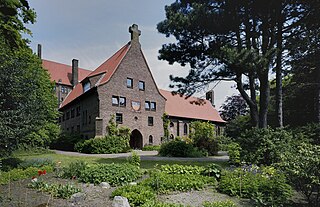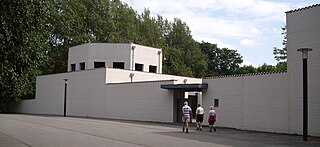
Rijnsburg Abbey (Dutch : Abdij van Rijnsburg) was a Benedictine nunnery in Rijnsburg, Netherlands, active between 1133 until 1574.

Rijnsburg Abbey (Dutch : Abdij van Rijnsburg) was a Benedictine nunnery in Rijnsburg, Netherlands, active between 1133 until 1574.
It was founded by Petronilla of Lorraine, regent of Holland, in 1133 and was thereafter under the protection of the countesses of Holland. The abbey only accepted female members of the nobility as members. It became the most prestigious women's religious house in Holland and grew very wealthy on donations during the centuries.
On the basis of the handed down liturgical manuscripts, it can be established that the Germanic liturgical practices were followed. [1] There is almost no reason to assume that the abbey Rijnsburg or its mother house Stötterlingenburg in the Northern Harz have ever belonged to the order of Cluny. [2]
It was pillaged and destroyed in 1574. In the center of Rijnsburg, as part of the current church, only one of the two towers of the Romanesque abbey church remains. [2]

Rijnsburg is a village in the eastern part of the municipality of Katwijk, in the western Netherlands, in the province of South Holland. It lies on the Oude Rijn, from which it takes its name.

Susteren Abbey is a former Benedictine abbey at Susteren near Roermond, in the Dutch province of Limburg, founded in the 8th century. The former abbey church is now St. Amelberga's Basilica.
Dirk VI was Count of Holland between 1121 and 1157, at first, during his minority, under the regency of his mother Petronilla. He was the son of Count Floris II. After his death he was succeeded by his eldest son Floris III. He married Sofie of Salm, Countess of Rheineck and Bentheim. She was heiress of Bentheim, which she ruled together with her husband and which was inherited by the couple's second son Otto after his parents' death.
Floris IV was the count of Holland from 1222 to 1234. He was born in The Hague, a son of William I of Holland and his first wife, Adelaide of Guelders.

Affligem Abbey is a Benedictine abbey in the historic village of Hekelgem, now in the municipality of Affligem, Flemish Brabant, Belgium, 19 km (12 mi) to the north-west of Brussels. Dedicated in 1086, it was the most important monastery in the Duchy of Brabant and therefore often called Primaria Brabantiae.
Westmalle Abbey, otherwise the Trappist Abbey of Westmalle, is a monastery of the Cistercians of Strict Observance in Westmalle in the Belgian province of Antwerp.

Brecht Abbey, also known as the Abbey of Our Lady of Nazareth, is an abbey of Trappistine nuns located in Brecht, in the Campine region of the province of Antwerp. Life in the abbey is characterized by prayer, reading and manual work, the three basic elements of Trappist life.

Munsterbilzen Abbey was an abbey of Benedictine nuns in Munsterbilzen, Limburg, Belgium, founded in around 670 by Saint Landrada. It was plundered by Vikings in 881 but restored. From the 9th century it was dedicated to Saint Amor.

Egmond Abbey or St. Adalbert's Abbey is a Benedictine monastery of the Congregation of the Annunciation, situated in Egmond-Binnen, in the municipality of Bergen, in the Dutch province of North Holland. Founded in 920-925, and destroyed during the Reformation, it was re-founded in 1935 as the present Sint-Adelbertabdij, in the Diocese of Haarlem.

Herkenrode Abbey was a Catholic monastery of Cistercian nuns located in Kuringen, part of the municipality of Hasselt, which lies in the province of Limburg, Belgium.
Ada of Scotland, also known as Ada of Huntingdon, was a member of the Scottish royal house who became Countess of Holland by marriage to Floris III, Count of Holland.
Adelaide of Guelders was the daughter of Count Otto I of Guelders and his wife, Richardis, the daughter of Duke Otto I of Bavaria and Agnes of Loon. Also known as Adelaide of Bellich or Alice of Guelders.
Sophia of Rheineck, also known as Sophie of Salm, Countess of Bentheim was a ruling suo jure Countess of Bentheim between 1150 and 1176. She was also countess consort of Holland by marriage to Dirk VI, Count of Holland, who was her co-ruler jure uxoris in the County of Bentheim.

Petronilla of Lorraine was Countess of Holland by marriage to Floris II, Count of Holland, and regent of the County of Holland during the minority of her son Dirk VI in 1121–1129. She was a daughter of Theodoric II, Duke of Lorraine and Hedwig of Formbach.

Drongen Abbey, or the Old Abbey, Drongen, is a monastic complex on the River Leie in Drongen, a part of the city of Ghent in East Flanders, Belgium.

Male Castle, Bruges. A community of the Canonesses Regular of the Holy Sepulchre. It originated in Bruges in the 11th century, and between 1954 and 2013 was settled in Male Castle in Male, Sint-Kruis, Bruges, West Flanders, Belgium.

Roosenberg Abbey was established in 1238 at Waasmunster, halfway between Ghent and Antwerp. The abbey is still operating at Waasmunster, though not on its original site. Its 750-year history has not been uninterrupted.

Lilbosch Abbey is a monastery of the Trappists founded in 1883 and located in Lilboscherveld in Pepinusbrug, Echt, Limburg, in the Netherlands.
Ada of Holland was a Dutch abbess of Rijnsburg Abbey from 1239.

Dendermonde Abbey or the Abbey of Saints Peter and Paul is a Benedictine monastery in Dendermonde (Belgium), which played a role in the Liturgical Movement in Belgium.